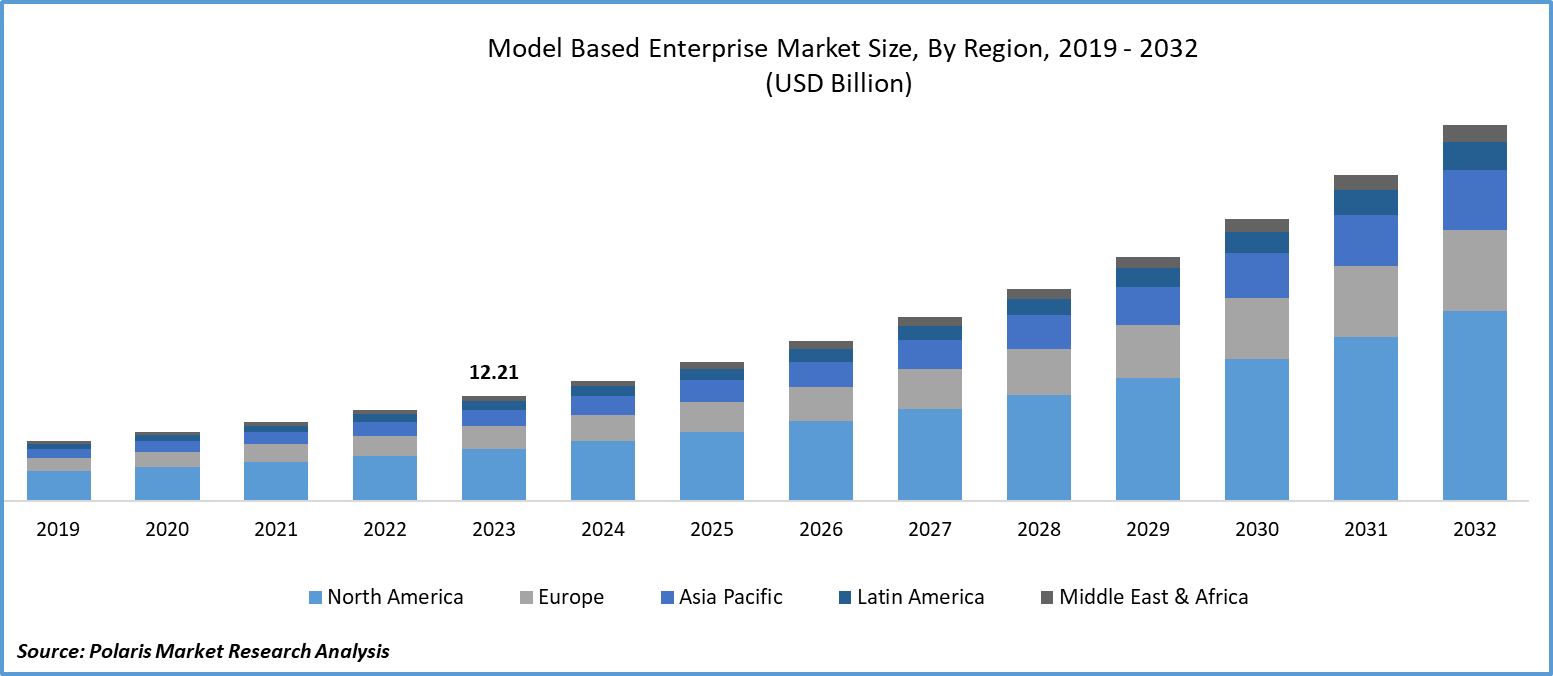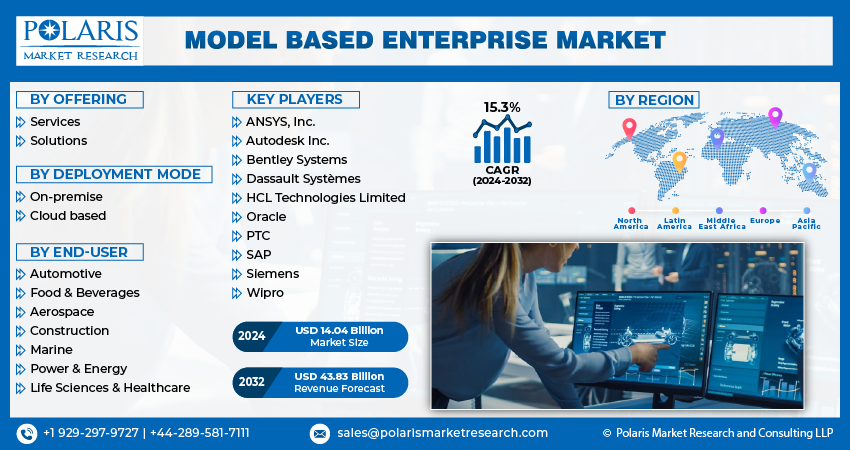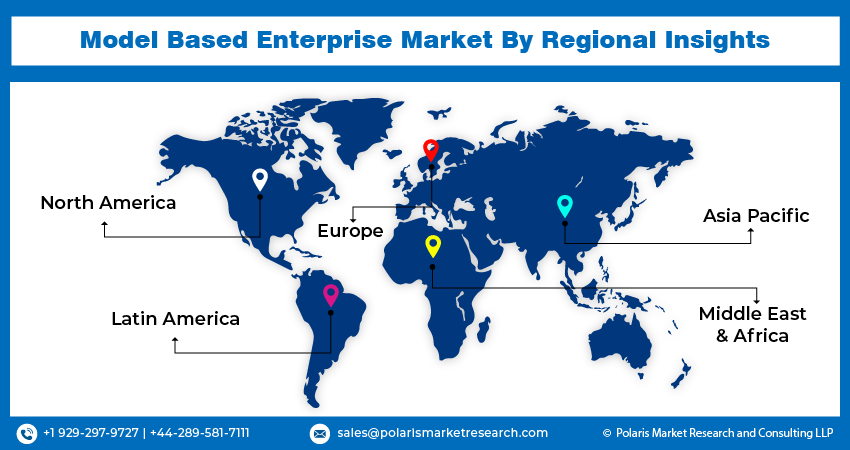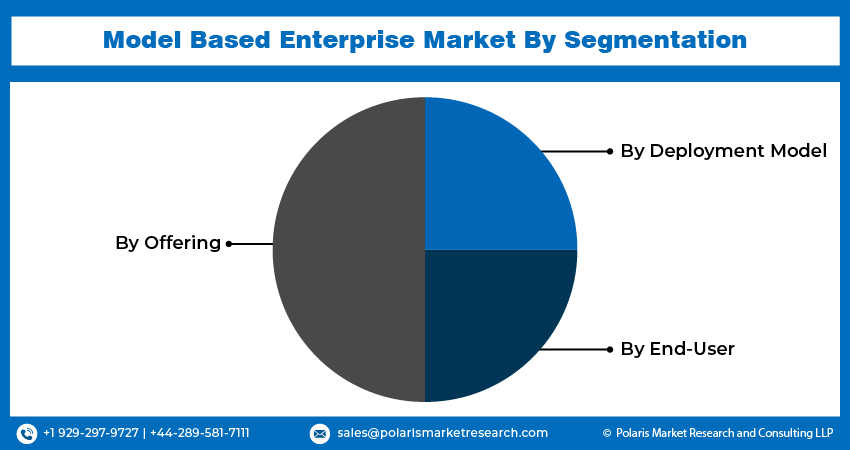
Model Based Enterprise Market Share, Size, Trends, Industry Analysis Report
By Offering (Services, Solutions); By Deployment Mode (On-premise, Cloud based); By End-User; By Region; Segment Forecast, 2024 - 2032
- Published Date:Apr-2024
- Pages: 117
- Format: PDF
- Report ID: PM4862
- Base Year: 2023
- Historical Data: 2019-2022
Report Outlook
Model Based Enterprise Market size was valued at USD 12.21 billion in 2023. The market is anticipated to grow from USD 14.04 billion in 2024 to USD 43.83 billion by 2032, exhibiting the CAGR of 15.3% during the forecast period
Model Based Enterprise Market Overview
Rising consumer demand and an increase in the number of people moving towards the adoption of integration of a Model-Based Enterprise (MBE) methodology facilitates seamless coordination between the design and production departments. Reducing the time needed to create drawings and the costs associated with paper, printing, and storage lowers total production costs. All downstream stakeholders gain from it since it enhances communication throughout the company and simplifies the product development cycle. Modern model-based approaches and technology are emerging to enable product development digitally to provide digital representations of actual business processes and products.

To Understand More About this Research:Request a Free Sample Report
- For instance, in April 2024, GenAI (Sarvam AI), a start-up, raised $41 million in funding led by Lightspeed to develop a product that can be used to train custom AI models or an enterprise-grade platform.
However, during the pandemic, there was a surge in the adoption of cloud-based deployment of model-based enterprises to achieve digital transformation in the business management process. This process analyzes and forms business development strategies, monitors real-time progress, and enhances production capacity cost-effectively. This not only improves production capacity but also ensures a seamless production process experience for manufacturers.
The recent increasing trend of MBE 2.0 which is making it easier to build a networked, data-centric company by providing an aggregated "data bus" that makes business, process, and product data accessible to all enterprise network nodes, allowing for the use of analytics to provide new insights. Digital technologies like IoT, machine learning, and digital twins can improve the capacity to obtain those insights quickly and create a comprehensive digital thread that extends to both consumers and suppliers. This aids producers in accurately estimating demand and modifying their rates of production accordingly.

Model Based Enterprise Market Dynamics
Market Drivers
- Rise in adoption of cloud- based platforms
The rising awareness of the proliferation of devices and advanced principal technologies has fueled the emergence of IoT technology. Large geographic areas are covered by wide-area IoT networks, where linked gadgets normally exchange little amounts of data. Sensor-embedded IoT has grown more affordable, and a wider range of applications, including extensive monitoring and detection, are now feasible. Moreover, the collection of data and actuators to manage process operations aids MBE, enabling 3D annotation data modeling, which is essential in the creation, manufacture, and upkeep of complicated items.
- Rise in adoption of digital twin technology
The adoption of digital twin technologies has led businesses to be able to verify a product prior to its release into the market. A duplicate of the intended manufacturing process can be made in order to detect any process malfunctions and provide output in real time, reducing the expense of product failure. The system is able to create erratic situations, identify appropriate mitigation techniques, and analyze the system's response. This increased capacity may speed up the creation of new goods, increase the accuracy of risk assessments, and improve the dependability of operating lines.
Market Restraints
- Lack of skilled professionals
The scarcity of trained professionals is one of the restraining factors in the adoption of model-based enterprise strategies. It requires highly skilled workers who possess expertise in the specific industry and product area, know how to use digital technologies and can analyze and comprehend complex data. That being said, new technologies are always being developed, and the MBE industry is always evolving. As a result, given that it calls for ongoing training and education, it might be challenging for certain employees and organizations to stay up with these advances.
Report Segmentation
The market is primarily segmented based on offering, deployment mode, end-user, and region.
|
By Offering |
By Deployment Mode |
By End-User |
By Region |
|
|
|
|
To Understand the Scope of this Report:Speak to Analyst
Model Based Enterprise Market Segmental Analysis
By Offering Analysis
- The services segment led the industry market with substantial revenue share, largely attributable to its ability to offer reduced production time and cost of production to accelerate product development cycles by streamlining communication, minimizing bottlenecks, and optimizing workflows effectively to produce optimized results.
- The solutions segment is projected to grow at a CAGR during the projected period, mainly driven by its technology integration in model-based enterprises, which provide the standards for the data source and product requirements across the product lifecycle. The segment uses modeling and simulation technologies to integrate and manage its technical and business processes.
By Deployment Mode Analysis
- The on-premise deployment segment accounted for the largest market share and is likely to retain its market position throughout the forecast period. In this, businesses own all of their data and have complete control over it to avoid any real-time data alterations, data leaks, or breaches. Companies that handle extremely sensitive data need to have the protection and privacy that an on-premises deployment offers. Regardless of the industry, a large number of businesses nowadays are subject to regulatory regulation. It is crucial for businesses must abide by these rules to always be compliant and aware of the location of their data.
- The cloud-based segment is expected to grow at the fastest growth rate over the next coming years on account of the rapid increase; the data and encryption keys are stored with third-party providers; hence, they might not be able to access the data in the event of an unforeseen circumstance. Security risks are a major concern, ranging from the loss of intellectual property to the disclosure of employee personal information like login credentials. Although, improvements in technological advancements have led to improved safety and privacy for consumers.
By End-User Analysis
- The aerospace segment has dominated the model-based enterprise market due to the organization's virtual depiction of the product concept, related technical data, and requirements, as businesses use 3D modeling and simulation to cut costs, improve quality, and shorten time to market. Product lifecycle management (PLM), enterprise resource planning (ERP), and manufacturing execution systems/manufacturing operations management tools are still crucial components of the model-based enterprise approach used in the aerospace sector for the quick deployment of aircraft products and the development of a comprehensive view of the entire value chain.
- The automotive segment is anticipated to grow with the highest CAGR during the forecast period due to the gradual shift of the automotive sector towards 3D virtual models, which provide a chance to greatly increase reuse, enhance design efficiency, save costs, and enhance quality throughout the whole organization. This will boost the production and manufacturing capacity of the automobile sector, driving the anticipated growth of this segment.
Model Based Enterprise Market Regional Insights
The North America region dominated the global market with the largest market share
The North America region dominated the global market with the largest market share in 2023 and is expected to maintain its dominance over the anticipated period. The growth of the segment market can be largely attributed to the rapidly increasing demand for digital models for constructing models of the people and organizations engaged in business processes, systems, and products. It aims to increase the enterprise's efficacy and efficiency by facilitating decision-making, communication, and teamwork through the use of these digital models. It offers digital models of business processes, goods, and systems that may be more accurate than the already existing methods. These are some of the driving factors for this region.
The Asia Pacific region is expected to be the fastest-growing region with a healthy CAGR during the projected period, owing to the increase in public awareness of the model-based enterprise. The expanding use of automation and digitalization in industrial operations is one of the factors contributing to the rise in MBE demand with an understanding of advanced manufacturing technologies.

Competitive Landscape
The model based enterprise market is fragmented and is anticipated to witness competition due to several players' presence. The transformation is fueled by digital models and shift towards model-based practices to ensure efficiency, integrity, and safety. These players focus on partnership, product upgrades, technology integration and collaboration to gain a competitive edge over others and capture a significant market share.
Some of the major players operating in the global market include:
- ANSYS, Inc.
- Autodesk Inc.
- Bentley Systems
- Dassault Systèmes
- HCL Technologies Limited
- Oracle
- PTC
- SAP
- Siemens
- Wipro
Recent Developments
- In April 2024, o9, the leading enterprise AI software, announced its collaboration with Microsoft by integrating Microsoft Azure OpenAI Services with o9 to improve supply chain operations and make them more efficient using AI-powered planning capabilities.
- In February 2024, IBM Announces Mistral AI Model Open-Source on Watsonx to help Increasing Model Selection to Support Enterprises in Scaling AI with Confidence and Flexibility. This cloud can cut latency by up to 75% and can help speed up processing to lower energy consumption and costs.
Report Coverage
The model based enterprise market report emphasizes on key regions across the globe to provide better understanding of the product to the users. Also, the report provides market insights into recent developments, trends and analyzes the technologies that are gaining traction around the globe. Furthermore, the report covers in-depth qualitative analysis pertaining to various paradigm shifts associated with the transformation of these solutions.
The report provides detailed analysis of the market while focusing on various key aspects such as competitive analysis, offering, deployment mode, end-users, and their futuristic growth opportunities.
Model Based Enterprise Market Report Scope
|
Report Attributes |
Details |
|
Market size value in 2024 |
USD 14.04 billion |
|
Revenue forecast in 2032 |
USD 43.83 billion |
|
CAGR |
15.3% from 2024 – 2032 |
|
Base year |
2023 |
|
Historical data |
2019 – 2022 |
|
Forecast period |
2024 – 2032 |
|
Quantitative units |
Revenue in USD billion and CAGR from 2024 to 2032 |
|
Segments covered |
By Offering, By Deployment Mode, By End-User, By Region |
|
Regional scope |
North America, Europe, Asia Pacific, Latin America; Middle East & Africa |
|
Customization |
Report customization as per your requirements with respect to countries, region and segmentation. |
FAQ's
The Model Based Enterprise Market report covering key segments are offering, deployment mode, end-user, and region.
Model Based Enterprise Market Size Worth $43.83 Billion By 2032.
Model Based Enterprise Market exhibiting the CAGR of 15.3% during the forecast period
North America is leading the global market
key driving factors in Model Based Enterprise Market are rise in adoption of cloud- based platforms

